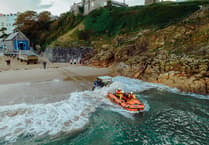Archaeologists have discovered extremely rare evidence for early Homo sapiens in Britain buried beneath Pembroke Castle.
The finds of stone tools and animal bones, dating to the last Ice Age, were found during archaeological excavations at Pembroke Castle’s Wogan Cavern. Their excavations will continue this summer, starting tomorrow (Monday) and lasting for four weeks.
Wogan Cavern is a large cave underneath Pembroke Castle. In the early 13th century, a wall was built across the cave mouth. It is now accessed via a spiral stairway from the castle above. A team of archaeologists have so far excavated only a very small part of the cave but their finds already make it among the most important archaeological caves in Britain.

The team, led by Dr Rob Dinnis of the University of Aberdeen and Dr Jennifer French of the University of Liverpool, found evidence for multiple early prehistoric hunter-gatherer occupations over tens of thousands of years, stretching back into the last Ice Age.
Post-excavation analysis of stone tools found during the 2022 dig confirms that the tools were left behind by some of the earliest Homo sapiens to come to Britain, during the middle of the last Ice Age. They were found alongside the bones of Ice Age animals, including reindeer, wild horse and woolly mammoth.
The discovery of early Homo sapiens archaeology is hugely important. There are very few early Homo sapiens sites in Britain, and the other sites were almost entirely excavated out during the 19th and early 20th centuries.
Wogan Cavern offers the chance to use modern excavation methods and cutting-edge analytical techniques for the first time on a British early Homo sapiens site. The team is already testing new techniques, for example collecting sediment samples under controlled conditions, to be screened for ancient human and animal DNA (photo below).
New excavations this summer will soon be underway, funded by the Natural History Museum London and the Pembroke Castle Trust, and covered by History Hit, the podcast, SVOD and content platform founded by historian Dan Snow and acquired by award-winning digital content agency and media network Little Dot Studios
More information and updates will be available through the project’s website (wogancavern.org) and Twitter (@wogancavern), and Pembroke Castle’s website and Facebook page.
The team will publish more details of their work in the coming months.
Dr Rob Dinnis said: “Wogan Cavern is turning out to be a remarkable site. We’re sadly lagging behind our European neighbours in understanding the first local appearances of Homo sapiens, but the discovery of a new site can change that. We can now use modern archaeological methods to learn much more about this crucial period. When exactly did these people come to Britain, where did they come from, and how did they live in their Ice Age environments? These are all questions we can now try to answer, thanks to this incredible cave.
“Our work has already shown that Wogan Cavern is an extremely important site, but the most intriguing thing is how much we’ve found given how little we’ve excavated. It’s a big cave, and we’ve barely scratched the surface. Who knows what else we might find in coming years? Could there be evidence for even earlier occupation, by our Neanderthal cousins? Given what we’ve found so far, I certainly wouldn’t rule it out.”

Jon Williams, Manager, Pembroke Castle, added:“We are very excited to welcome back Rob and his team for another excavation season. Wogan Cavern has always been a special place of interest for our castle visitors, but the recent discoveries have taken that to another level. It is an important piece of work that is shining a new light on our distant prehistoric past.”
Tristan Hughes, presenter of History Hit said: “Wogan Cavern may well be the site that researchers of early humans in Britain have been waiting for. Given how much Rob and his team have already found - these tantalising Ice Age artefacts - the prospect that further evidence for some of the first Homo sapiens in Britain will be unearthed over the coming months is incredibly exciting. Could it be that excavations here will also reveal more about the enigmatic end of the Neanderthals in Britain too? Let’s see….. It is a great privilege for History Hit to be involved in the project.”




